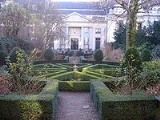
Museum Van Loon
Encyclopedia
Museum Van Loon is museum
, located in a canal
side house alongside the Keizersgracht in Amsterdam
, Netherlands
. The museum is named after the family Van Loon that lived in the house from the 19th century.
. From 1884 to 1945 the Van Loons lived in the house. Thora van Loon-Egidius, who lived in the house, was a lady-in-waiting
for Wilhelmina of the Netherlands
. She was proud of her German heritage and allegedly entertained Nazi officials during the occupation of Amsterdam at the house with her husband, Willem van Loon. The couple would go on to be shunned by upper class society.
work. The upstairs features several paintings of Roman sports figures and a bedroom that is decorated with a Romanticism
period painting of Italy. The house also has fake bedroom doors: the 18th-century owners desires to lack symmetry in the interior design so they painted the real bedroom doors to match the walls and fake doors to appear real in a location where one would assume a door would be.
Museum
A museum is an institution that cares for a collection of artifacts and other objects of scientific, artistic, cultural, or historical importance and makes them available for public viewing through exhibits that may be permanent or temporary. Most large museums are located in major cities...
, located in a canal
Canal
Canals are man-made channels for water. There are two types of canal:#Waterways: navigable transportation canals used for carrying ships and boats shipping goods and conveying people, further subdivided into two kinds:...
side house alongside the Keizersgracht in Amsterdam
Amsterdam
Amsterdam is the largest city and the capital of the Netherlands. The current position of Amsterdam as capital city of the Kingdom of the Netherlands is governed by the constitution of August 24, 1815 and its successors. Amsterdam has a population of 783,364 within city limits, an urban population...
, Netherlands
Netherlands
The Netherlands is a constituent country of the Kingdom of the Netherlands, located mainly in North-West Europe and with several islands in the Caribbean. Mainland Netherlands borders the North Sea to the north and west, Belgium to the south, and Germany to the east, and shares maritime borders...
. The museum is named after the family Van Loon that lived in the house from the 19th century.
History
The canal house where the museum resides was built in 1672, and served as the home of artist Ferdinand BolFerdinand Bol
Ferdinand Bol was a Dutch artist, etcher, and draftsman. Although his surviving work is rare, it displays Rembrandt's influence; like his master, Bol favored historical subjects, portraits, numerous self-portraits, and single figures in exotic finery.The street Ferdinand Bolstraat in Amsterdam was...
. From 1884 to 1945 the Van Loons lived in the house. Thora van Loon-Egidius, who lived in the house, was a lady-in-waiting
Lady-in-waiting
A lady-in-waiting is a female personal assistant at a royal court, attending on a queen, a princess, or a high-ranking noblewoman. Historically, in Europe a lady-in-waiting was often a noblewoman from a family highly thought of in good society, but was of lower rank than the woman on whom she...
for Wilhelmina of the Netherlands
Wilhelmina of the Netherlands
Wilhelmina was Queen regnant of the Kingdom of the Netherlands from 1890 to 1948. She ruled the Netherlands for fifty-eight years, longer than any other Dutch monarch. Her reign saw World War I and World War II, the economic crisis of 1933, and the decline of the Netherlands as a major colonial...
. She was proud of her German heritage and allegedly entertained Nazi officials during the occupation of Amsterdam at the house with her husband, Willem van Loon. The couple would go on to be shunned by upper class society.
Architecture and collection
The interior of the house has been renovated, and appears reminiscent of it's look in the 18th-century, with wood paneling and stuccoStucco
Stucco or render is a material made of an aggregate, a binder, and water. Stucco is applied wet and hardens to a very dense solid. It is used as decorative coating for walls and ceilings and as a sculptural and artistic material in architecture...
work. The upstairs features several paintings of Roman sports figures and a bedroom that is decorated with a Romanticism
Romanticism
Romanticism was an artistic, literary and intellectual movement that originated in the second half of the 18th century in Europe, and gained strength in reaction to the Industrial Revolution...
period painting of Italy. The house also has fake bedroom doors: the 18th-century owners desires to lack symmetry in the interior design so they painted the real bedroom doors to match the walls and fake doors to appear real in a location where one would assume a door would be.
External links
- Museum Van Loon (official website)

